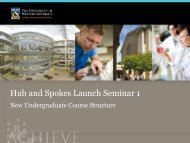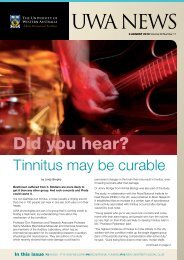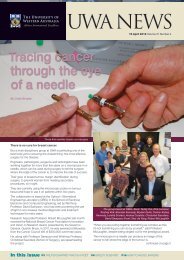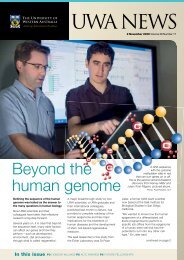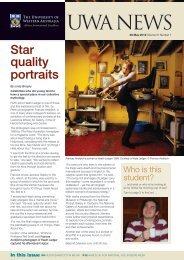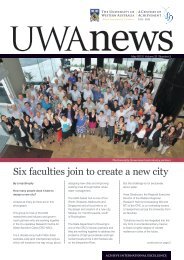Issue 13. 6 September 2010.pdf [PDF File, 1.7 MB] - UWA Staff - The ...
Issue 13. 6 September 2010.pdf [PDF File, 1.7 MB] - UWA Staff - The ...
Issue 13. 6 September 2010.pdf [PDF File, 1.7 MB] - UWA Staff - The ...
Create successful ePaper yourself
Turn your PDF publications into a flip-book with our unique Google optimized e-Paper software.
Trees start work on the<br />
Future Farm<br />
<strong>The</strong> ground is ready for 14,000 saplings<br />
While many staff were helping out at<br />
Open Day, others were getting their<br />
hands dirty down on the farm.<br />
Funding for tree planting at the Future<br />
Farm co-incided with the start of<br />
Professor Richard Hobbs’ Australian<br />
Laureate project work, so he decided to<br />
turn the tree-planting into a large-scale<br />
on-going experiment.<br />
Research Assistant Professor Rachel<br />
Standish is overseeing the plant aspect<br />
of ecosystem restoration on the farm<br />
near Pingelly. She and Professor Hobbs,<br />
together with Research Associates Mike<br />
Perring and Kris Hulvey (all Plant<br />
Biology), co-ordinated the planting of<br />
14,000 trees over two days, with a team<br />
of about 23 people each day.<br />
<strong>Staff</strong> and student volunteers joined<br />
members of Men of the Trees to plant<br />
eucalypts, wattles and banksias on<br />
20-odd hectares of farmland previously<br />
used for cropping and grazing.<br />
“My research group decided to take<br />
advantage of seed funding from our<br />
Dean Professor Tony O’Donnell and the<br />
Faculty of Natural and Agricultural<br />
Sciences to set up an experiment to<br />
examine the effects of different<br />
combinations of plants on various<br />
aspects of ecosystem functioning,”<br />
Professor Hobbs said.<br />
<strong>The</strong>se aspects include carbon storage,<br />
soil processes and resistance to invasion<br />
by non-native species.<br />
“We planted different combinations of<br />
trees and trees and shrubs in 128 plots,<br />
each about 25 metres square,” he said.<br />
“Depending on how fast they grow,<br />
we will see some results quickly, but the<br />
whole idea of the farm is to look to the<br />
future and we are laying the foundations<br />
for an experiment that will last for<br />
decades.”<br />
A/Professor Standish said they used the<br />
vegetation that had existed before the<br />
land had been cleared for farming as a<br />
guide for restoration. “York Gum<br />
woodland existed on the site prior to<br />
agriculture, so we selected plants from<br />
that vegetation type,” she said.<br />
<strong>The</strong> experiment will look at how different<br />
species assemblages and their microcommunities<br />
interact and affect carbon<br />
storage, the physical, chemical and<br />
biological properties of the soil, including<br />
the work of soil microbes and<br />
macrofauna (for example, termites),<br />
as well as pollination, recolonisation by<br />
native plants and animals and the<br />
invasion of weeds.<br />
Wattles fix nitrogen in the soil, while<br />
banksias extract nutrients in what<br />
Professor Hobbs describes as a<br />
peculiarly Western Australian way.<br />
“<strong>The</strong>y have an odd mechanism for<br />
extracting nutrients from impoverished<br />
soil,” he said.<br />
<strong>The</strong> Future Farm’s own Open Day will be<br />
on October 1st, with a theme of<br />
showcasing research on reducing<br />
greenhouse gas emissions. Visitors will<br />
be able to see research being done in<br />
this area through cropping, livestock<br />
innovations and tree planting.<br />
ABOVE: Students, staff and locals<br />
all pitched in together RIGHT: Rachel Standish<br />
Photos by Richard Hobbs and Cristina Ramalho<br />
<strong>The</strong> University of Western Australia <strong>UWA</strong> NEWS 6 <strong>September</strong> 2010 11


![Issue 13. 6 September 2010.pdf [PDF File, 1.7 MB] - UWA Staff - The ...](https://img.yumpu.com/26619782/11/500x640/issue-13-6-september-2010pdf-pdf-file-17-mb-uwa-staff-the-.jpg)
